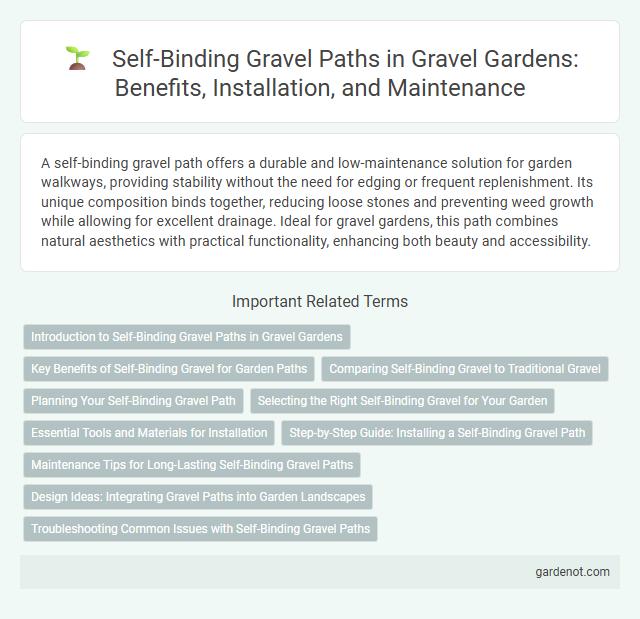A self-binding gravel path offers a durable and low-maintenance solution for garden walkways, providing stability without the need for edging or frequent replenishment. Its unique composition binds together, reducing loose stones and preventing weed growth while allowing for excellent drainage. Ideal for gravel gardens, this path combines natural aesthetics with practical functionality, enhancing both beauty and accessibility.
Introduction to Self-Binding Gravel Paths in Gravel Gardens
Self-binding gravel paths consist of crushed stone mixed with finer particles that bind the surface, creating a durable, low-maintenance walkway ideal for gravel gardens. This type of path enhances permeability, allowing rainwater to drain naturally while reducing runoff. Its natural aesthetic and firm texture provide an accessible, eco-friendly solution that complements the organic design of gravel garden landscapes.
Key Benefits of Self-Binding Gravel for Garden Paths
Self-binding gravel creates a durable, low-maintenance garden path by naturally compacting without the need for additional stabilizers. Its unique composition offers excellent drainage, preventing water pooling and reducing erosion along the path. This gravel type enhances safety with a firm, slip-resistant surface ideal for high-traffic garden areas.
Comparing Self-Binding Gravel to Traditional Gravel
Self-binding gravel creates a stable, compact surface by naturally binding the stones together, reducing loose gravel and maintenance compared to traditional gravel, which often requires frequent raking and replenishment. This type of gravel path offers enhanced durability and better resistance to erosion and weed growth. The bind also improves safety by minimizing slip hazards and providing a smoother walking or driving surface.
Planning Your Self-Binding Gravel Path
Planning your self-binding gravel path requires careful selection of materials, including crushed stone and fine aggregate, to ensure durability and proper drainage. Accurately measuring the area and preparing a solid sub-base with compacted hardcore prevents shifting and uneven surfaces. Designing the path with a slight camber or slope aids in water runoff, maintaining the integrity and longevity of your gravel pathway.
Selecting the Right Self-Binding Gravel for Your Garden
Selecting the right self-binding gravel for your garden path requires considering factors such as particle size, color, and durability to ensure a stable and attractive surface. Opt for gravel with a mix of fine and coarse particles to promote compaction and prevent shifting, ideally composed of crushed limestone or granite for long-lasting binding properties. Proper drainage and maintenance also play a crucial role in preserving the path's integrity and aesthetic appeal over time.
Essential Tools and Materials for Installation
Essential tools and materials for installing a self-binding gravel path include a garden rake, shovel, plate compactor, and landscape fabric to ensure proper ground preparation and stability. High-quality crushed gravel with self-binding properties, such as crushed limestone or granite, provides a durable and firm surface. Edging materials like metal or timber secure the path boundaries, preventing gravel migration and maintaining a clean, defined walkway.
Step-by-Step Guide: Installing a Self-Binding Gravel Path
Creating a self-binding gravel path involves preparing the base by excavating the area to a depth of 100-150mm and laying a geotextile membrane to prevent weed growth. Next, compact a sub-base of crushed stone before spreading and leveling the self-binding gravel, typically made of crushed limestone or sandstone that naturally hardens when wet. Finish by compacting the gravel with a plate compactor to form a stable, durable, and visually appealing pathway ideal for garden access and borders.
Maintenance Tips for Long-Lasting Self-Binding Gravel Paths
Regularly rake self-binding gravel paths to prevent weed growth and maintain an even surface. Replace any displaced stones promptly to ensure structural integrity and avoid bare patches. Applying a weed suppressant and checking drainage periodically will extend the lifespan of the path while preserving its aesthetic.
Design Ideas: Integrating Gravel Paths into Garden Landscapes
Self-binding gravel paths offer durable, low-maintenance walkways perfect for garden landscapes, combining natural aesthetics with practical function. Design ideas for integrating these paths include curving routes to complement garden beds, incorporating edging materials like natural stone or metal to define boundaries, and mixing gravel colors to create visual interest and contrast. These elements enhance garden flow, guiding visitors while maintaining permeability for plant health and soil drainage.
Troubleshooting Common Issues with Self-Binding Gravel Paths
Self-binding gravel paths often face issues such as poor drainage, weed growth, and surface erosion that can compromise stability and aesthetics. Ensuring proper base preparation with compacted sub-base materials and using a high-quality, angular self-binding gravel mix helps mitigate these problems. Regular maintenance involving regrading, weed control, and prompt repair of damaged areas extends the lifespan and durability of self-binding gravel paths.
Self-binding gravel path Infographic

 gardenot.com
gardenot.com